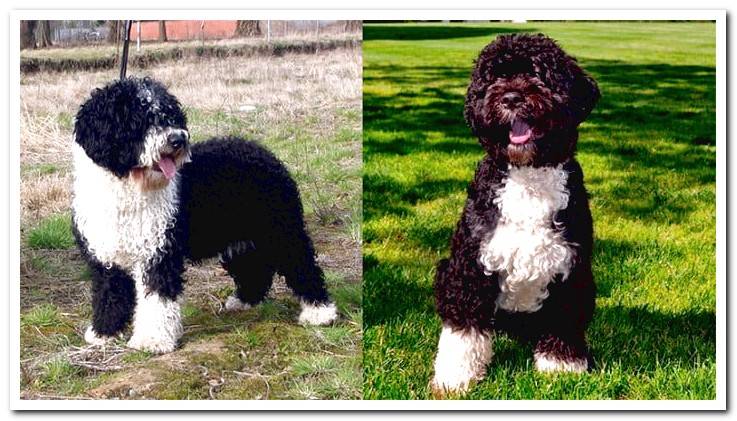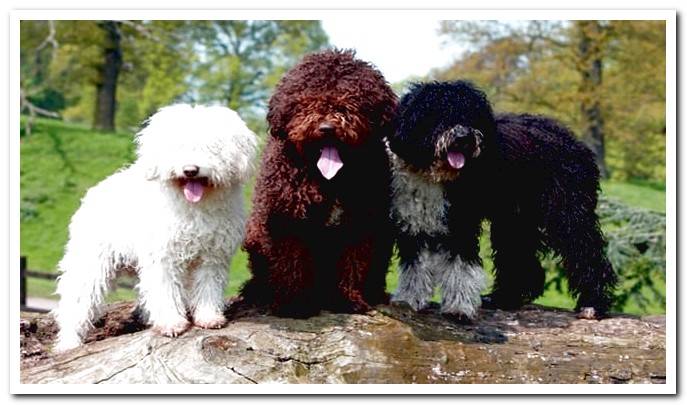
There are several lines of water dogs and each of them has its own characteristics, although some are difficult to differentiate at first glance. The differences between the best known Spanish and Portuguese water dogs are the weight and the coat, although there are also other characteristics that allow them to be distinguished.
Are you thinking of adopting a water dog and don’t know which variety to choose? Here are the characteristics and differences between the Spanish and the Portuguese water dog.
Index of contents
- 1 Characteristics of the Spanish water dog
- 2 Characteristics of the Portuguese water dog
- 3 Differences between the Spanish and the Portuguese water dog
Characteristics of the Spanish water dog
As its name implies, this water dog is originally from Spain, where it is raised as a shepherd. The exact time of its arrival on the peninsula is unknown, although some theories claim that it was brought by Muslims from North Africa.
The Spanish water dog measures between 44 and 50 cm (males) and 40 to 46 cm (females). In addition, its weight is between 14 and 22 kilos.
As for the body size, it is medium, rustic and harmonious. It stands out for its muscular build, although without looking heavy.
The eyes are oblique and expressive. The color of the iris varies in different shades: brown, chestnut and hazelnut. The coat is curly, short and woolly, forming cords when rolled. The coat comes in various shades: solid white, black or brown; bicolor in combinations of black and white or white and brown.
He is a playful, loyal and work oriented puppy. You can train it without much effort, because it learns quickly and is very intelligent.

Characteristics of the Portuguese water dog
The portuguese water dog It is native to the Algarve, from where it spread to the entire territory of Portugal during antiquity, although the exact moment of history is unknown.
This dog was a crucial element in Portuguese fishing, since it was used to recover fish. For this reason, it is a breed designed for the job.
The breed measures between 50 and 57 cm (males) and 43 to 52 cm (females). As for the weight, it varies between 16 to 25 kilos.
The Portuguese water dog is medium, muscular and straight in shape. The eyes are rounded and slightly separated, the iris is black or brown, surrounded by eyelids in the same tones.
As for the coat, it is abundant and grows in two ways: long and wavy, or short and curly. In both cases, it lacks an inner layer. Long-haired dogs have a matte and soft coat, while the long variety is dull and with closed curls.
Like the Spanish water dog, the Portuguese coat can be unicolor or bicolor. They share the same tones mentioned, with the difference that the Portuguese’s skin is black with bluish hues.
He is very athletic and loves outdoor activities, especially going swimming and playing in the water. He is obedient, easy to train and very smart. In addition, it has excellent sight and smell.
Differences between the Spanish and the Portuguese water dog
As you may have noticed, these two breeds share many characteristics, such as their ease of training and their personality. However, they also present elements that differentiate them:
- Fur: While Spanish only has long hair, Portuguese can have a long or short coat. In addition, the coat of the Spanish grows in cords, while that of the Portuguese forms more defined curls.
- Size: although by a few centimeters, the Portuguese water dog is larger than the Spanish.
- Weight: In addition to the larger size, the Portuguese water dog is also heavier than the Spanish.
- Musculature: both are strong water dogs, but the work together with the Portuguese fishermen contributed to the fact that the breed will develop a more massive and noticeable musculature.
- Eyes: the eyes of the Spanish water dog are oblique, while the Portuguese has round ones. Similarly, the color of the iris varies between the two.
- Muzzle shape: the Portuguese water dog’s muzzle is notoriously longer than that of its Spanish companion.
- Tail: the tail of both dogs is high insertion, but the Portuguese tail decreases representatively in size as it moves away from the base.
These are the differences between a Spanish and a Portuguese water dog. Which one will you adopt now?
